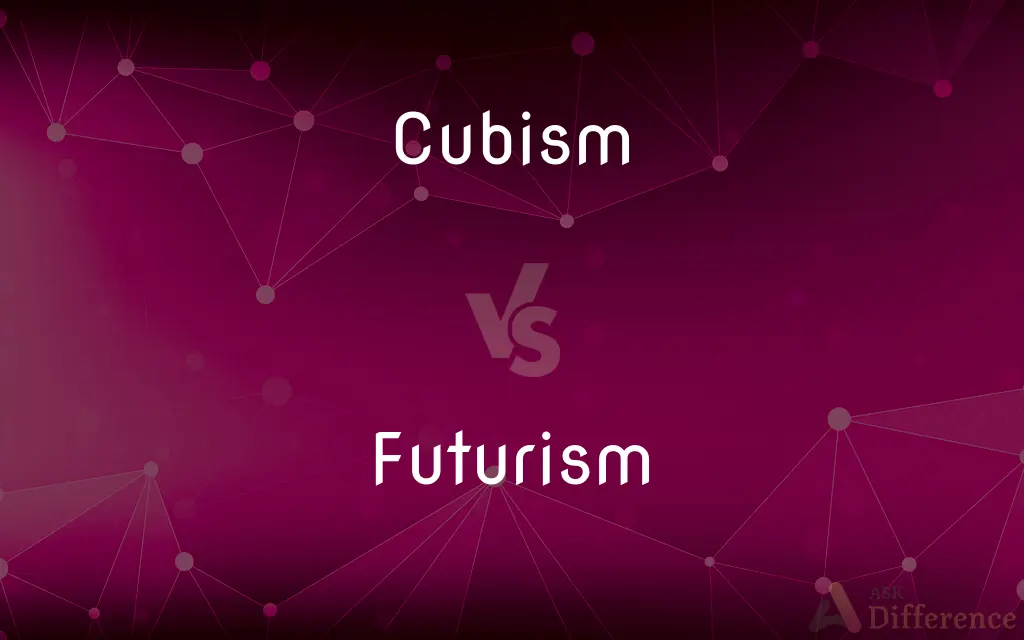Cubism vs. Futurism — What's the Difference?
Edited by Tayyaba Rehman — By Fiza Rafique — Updated on November 3, 2023
Cubism vs. Futurism: Cubism fragmented objects into geometric forms; Futurism emphasized speed and technology, projecting dynamic movement.

Difference Between Cubism and Futurism
Table of Contents
ADVERTISEMENT
Key Differences
Cubism was an artistic movement focused on geometric shapes and multiple perspectives. Futurism, in contrast, emphasized the dynamism of the modern world, especially technology and speed. Both movements sought to break away from traditional artistic representations, but Cubism did so through static decomposition of forms, while Futurism conveyed motion and change.
In Cubism, artists like Picasso and Braque reduced objects to their geometric essentials, often using a monochromatic palette. Futurism, founded by Filippo Tommaso Marinetti, was more focused on the future, depicting vibrant scenes of machines, cars, and industrial cities with vivid colors. Where Cubism was analytical and contemplative, Futurism was aggressive and forward-thinking.
Cubism's influence can be seen in the way it challenged the concept of perspective, which had dominated art since the Renaissance. Futurism's influence is evident in its celebration of modernity and its attempt to capture the essence of motion, which affected not only art but also design, fashion, and even literature.
Cubism often involved dissecting objects and viewing them from several angles simultaneously within the same canvas. Futurism was less concerned with form and more with creating a sense of movement and energy, often using lines to direct the viewer’s eye across the canvas.
While Cubism was more about understanding form and the essence of objects, Futurism was a response to the excitement of the changing world, reflecting a love for speed, technology, and urban life. Both movements were revolutionary, but Cubism's legacy is in its profound impact on the visual language of modern art, whereas Futurism's is seen in its approach to representing motion and its enthusiasm for the future.
ADVERTISEMENT
Comparison Chart
Time Period
Early 20th century (1907-1914)
Early 20th century (1909-1944)
Key Focus
Geometric shapes, multiple perspectives
Speed, technology, and future
Tone and Palette
Neutral, monochromatic
Bright, vivid colors
Subject Treatment
Static, fragmented objects
Dynamic, moving subjects
Legacy
Influenced modern visual language
Influenced perceptions of modernity and motion
Compare with Definitions
Cubism
A style where artists depicted subjects from multiple angles in the same painting.
His Cubism-inspired sculpture presented the human figure from three different viewpoints.
Futurism
Art movement emphasizing movement and the visual effects of time passing.
The painting’s blurred lines and overlapping shapes were a nod to Futurism.
Cubism
A movement that challenged traditional perspectives in painting and sculpture.
She wrote her thesis on Cubism and its impact on modern art.
Futurism
A cultural movement that sought to capture the sensation of speed and force.
The design of the car was inspired by Futurism, reflecting a fascination with speed.
Cubism
An early 20th-century art movement breaking down objects into geometric shapes.
The gallery displayed a painting that epitomized Cubism, with its fragmented geometric forms.
Futurism
An artistic movement celebrating dynamic energy and the machine age.
The sculpture's sleek lines and polished surfaces captured the essence of Futurism.
Cubism
Art characterized by monochromatic colors and complex, abstract imagery.
The Cubism period in his work is marked by the use of muted colors and flattened forms.
Futurism
A rejection of the past, focusing on the innovations of the future.
Futurism was evident in the fashion collection, with its forward-looking, unconventional designs.
Cubism
A revolutionary approach in visual art that influenced painting, literature, and architecture.
The architect’s Cubism influence was evident in the building's interlocking geometric shapes.
Futurism
Futurism (Italian: Futurismo) was an artistic and social movement that originated in Italy in the early 20th century which later also developed in Russia. It emphasized dynamism, speed, technology, youth, violence, and objects such as the car, the airplane, and the industrial city.
Cubism
Cubism is an early-20th-century avant-garde art movement that revolutionized European painting and sculpture, and inspired related movements in music, literature and architecture. In Cubist artwork, objects are analyzed, broken up and reassembled in an abstracted form—instead of depicting objects from a single viewpoint, the artist depicts the subject from a multitude of viewpoints to represent the subject in a greater context.
Futurism
A belief that the meaning of life and one's personal fulfillment lie in the future and not in the present or past.
Cubism
A nonobjective school of painting and sculpture developed in Paris in the early 20th century, characterized by the reduction and fragmentation of natural forms into abstract, often geometric structures usually rendered as a set of discrete planes.
Futurism
An artistic movement originating in Italy around 1910 whose aim was to express the energetic, dynamic, and violent quality of contemporary life, especially as embodied in the motion and force of modern machinery.
Cubism
An artistic movement in the early 20th Century characterized by the depiction of natural forms as geometric structures of planes.
Futurism
(Christianity) A belief that biblical prophecies, especially those contained in the book of Revelation, will be literally fulfilled at some point in the future.
Cubism
A movement or phase in post-impressionism (which see, below).
Futurism
(art) An early 20th century avant-garde art movement focused on speed, the mechanical, and the modern, which took a deeply antagonistic attitude to traditional artistic conventions.
Cubism
An artistic movement in France beginning in 1907 that featured surfaces of geometrical planes
Futurism
The study and prediction of possible futures.
Futurism
(Judaism) The Jewish expectation of the messiah in the future rather than recognizing him in the presence of Christ.
Futurism
(Christianity) Eschatological interpretations associating some Biblical prophecies with future events yet to be fulfilled, including the Second Coming.
Futurism
A movement or phase of post-impressionism (which see, below).
Futurism
A point of view that finds meaning or fulfillment in the future rather than in the past or present. The philosophy of a futurist.
Futurism
An artistic movement in Italy around 1910 that tried to express the energy and values of the machine age
Futurism
The position that the meaning of life should be sought in the future
Futurism
A style focused on themes of speed, technology, and industrial cities.
His novel captured the spirit of Futurism, with its protagonist racing against time.
Common Curiosities
What is Futurism?
Futurism is an artistic and social movement that originated in Italy in the early 20th century, emphasizing speed, technology, youth, violence, and objects such as the car, the airplane, and the industrial city.
Who are the main artists associated with Cubism?
Pablo Picasso and Georges Braque are considered the pioneers of Cubism.
What are the key characteristics of Cubism?
Key characteristics of Cubism include abstracted and geometric shapes, multiple perspectives, and the collapsing of three-dimensional space onto a two-dimensional plane.
Are there different phases of Cubism?
Analytic Cubism (1907-1912) and Synthetic Cubism (1912 onwards).
Who founded Futurism?
Futurism was founded by Italian poet Filippo Tommaso Marinetti, who wrote the "Futurist Manifesto" in 1909.
Did Cubism solely focus on visual arts?
While primarily associated with visual arts, Cubism also influenced literature and music, with creators experimenting with fragmented forms and perspectives.
What is Cubism?
Cubism is an art movement that revolutionized European painting and sculpture in the early 20th century, characterized by fragmented subject matter deconstructed in geometric forms.
Did Futurism have a political aspect?
Yes, Futurism had strong political aspects, with many futurists aligning with radical and nationalist politics, including fascism.
How is motion depicted in Futurist works?
In Futurism, motion is depicted as dynamic and forceful, often using lines and color to create rhythm and speed.
Did Futurism have an impact on graphic design?
Yes, Futurism significantly impacted graphic design, introducing bold typographic innovations and layouts that expressed movement and dynamism.
How did Futurism influence art and culture?
Futurism influenced art and culture by advocating modernity and seeking to capture the dynamic energy of the 20th century, influencing areas such as fashion, architecture, literature, and even music.
How did Cubism impact later art movements?
Cubism had a profound influence on later movements such as abstract art, Dadaism, and Surrealism.
Is Cubism considered abstract?
Cubism is considered a precursor to abstract art, though it still often retains ties to the real world through the use of fragmented objects.
Can Futurism be seen in today's culture?
Elements of Futurism can still be seen today, particularly in the focus on technology, speed, and youth culture in contemporary art and society.
How did World War I affect Cubism and Futurism?
World War I disrupted both movements; while Cubism declined as artists were drawn to more realist and somber themes, Futurism was invigorated by the war's technology and violence, consistent with its themes of energy and change.
Share Your Discovery

Previous Comparison
Echidna vs. Hedgehog
Next Comparison
Guild vs. ClanAuthor Spotlight
Written by
Fiza RafiqueFiza Rafique is a skilled content writer at AskDifference.com, where she meticulously refines and enhances written pieces. Drawing from her vast editorial expertise, Fiza ensures clarity, accuracy, and precision in every article. Passionate about language, she continually seeks to elevate the quality of content for readers worldwide.
Edited by
Tayyaba RehmanTayyaba Rehman is a distinguished writer, currently serving as a primary contributor to askdifference.com. As a researcher in semantics and etymology, Tayyaba's passion for the complexity of languages and their distinctions has found a perfect home on the platform. Tayyaba delves into the intricacies of language, distinguishing between commonly confused words and phrases, thereby providing clarity for readers worldwide.
















































